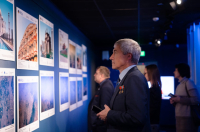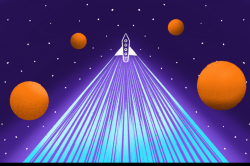Early space exploration was sparked by contributions from scientists from all over the world. In Russia, a great deal of theoretical basis for it was produced by Konstantin Tsiolkovsky; the works of German and British physicists have been influential, as well. However, the first “space realist” was the American inventor Robert Goddard, many of whose inventions are still relevant in today’s aeuronatics.

Robert Goddard. Credit: space.com
Another key persona is the German engineer Max Valier, who experimented with solid- and liquid-fuel rocket engines. The inventor had applied his devices to all sort of things, such as various aircraft and even automobiles. For instance, he collaborated with the automotive company Opel to create rocket-powered cars – one can still be seen at Opel’s headquarters today. Valier was the first to realize that solid-fuel engines are ineffective, as such setups cannot be controlled – once ignited, they cannot be stopped until they run out of fuel. He switched to liquid fuel, but passed away in 1930 during an unfortunate experiment. It was his works that inspired the scientists that created the German V2 rocket.
In USSR, two bureaus worked on the matters of space and aeronautics: the St. Petersburg Gas Dynamics Laboratory worked on rocket engines, while the Moscow-based Group for the Study of Reactive Motion built rockets based on those engines. In 1932, the two were combined into the Reaction-Engine Science Research Institute.
Getting into space

Laika the astronaut dog
Where is the edge of space? The physical “border” of space is called the Karman line. When planes fly through the atmosphere, they have to constantly exert force to stay in the air; in space, all flight is done through inertia. The Karman line is the conventional line where the amount of force needed to maintain atmospheric flight becomes higher than the amount of force needed to maintain orbital flight and is located approximately 100 km above sea level. But when did humanity first break through the atmosphere and reach space? Many would assume that happened on October 4, 1957, with the launch of Sputnik, but it was actually in 1942, in the course of German rocket testing. In 1942, man-made rockets reached the altitude of 90 km; in 1944, they climbed up 175 km. It was the V2 rocket that first broke through the Karman line and reached space. After World War Two, USA and USSR built their space industries off of this research.
The first animal in space is often thought to be the Soviet dog Laika, who went to space on November 3, 1957, just a month after Sputnik. But the first animal astronauts were the four monkeys sent up by US scientists in 1949.

Baikonur spaceport
In USSR, tests of the V2 rocket were conducted at the Kapustin Yat launch site in Astrakhan Oblast. The R-1 rocket, based on V2, was legendary scientist Sergey Korolev’s first major project. This was a military mid-range rocket and was employed by the Soviet Army.
There are a total of seven spaceports in Russia: Baikonur, Plesetsk, Vostochny, Kapustin Yar, Sea Launnch, Svobodny and Yasniy.
Abroad
The US has about the same number of spaceports as Russia (the Sea Launch spaceport is considered a joint project). Cape Canaveral hosts an Air Force Space Command station and several key launchpads. Nearby is the Kennedy Space Center, where until recently space shuttle crews were trained. It currently launches two types of rockets: the privately-owned Falcon and NASA’s Space Launch System. It is also where the Vehicle Assembly Building – the world’s largest single-story building and one of the biggest by volume – is located. The Vandenberg Air Force Base is in California and serves as the launch site for military and commercial satellites, as well as the test site for ICBMs.

Kennedy Space Center
How to get there
If your dream is to see a rocket launch, you’re in luck. Cape Canaveral has a remarkably well-serviced visitor center visited by thousands of people every day and is located an hour’s drive away from Orlando. For a special fee, you may even have dinner with an astronaut or watch a rocket launch.
In Russia, this is a bit more complicated. There are two spaceports that conduct rocket launches as of now – Baikonur and Plesetsk. Visitors are not allowed to the latter, but you can visit the nearby settlements of Savinskoe or Kargapol and watch the rockets launch from just 5 kilometers away. Make sure that you don’t cross over into the restricted area – guards are armed and wary!
Baikonur is easier to get to – a three-day tour there will cost you about 100,000 rubles. Another option is to get a science grant for the development of a satellite, create one, have Roskosmos launch it and be allowed onto the grounds. Finally, you can rough it and go out there on your own – many travelers choose to get to Baikonur by car or by train.





